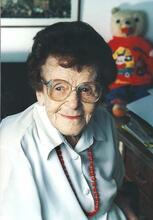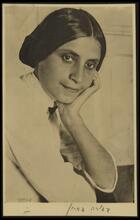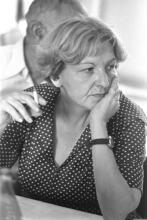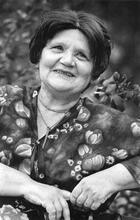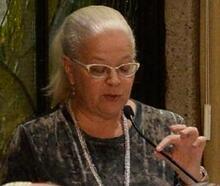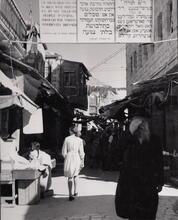Havvah Shapiro
Dubbing herself Eim Kol Hai (“Mother of All Living,” like the biblical Eve), Hava Shapiro cast herself as partner to the male progenitors of modern Hebrew literature. Her efforts yielded nearly 100 publications over a four-decade career, ranging from fiction to literary criticism to reportage. Born in Slavuta, Volhynia (modern-day Ukraine), in the Pale of Settlement and steeped in both Hebrew letters and Russian and Western literatures, she broke nearly every mold of traditional Jewish life: divorcing her husband and leaving her only son, engaging in an extra-marital affair, and pursing a PhD followed by a career in Hebrew journalism. Her extraordinary abilities captured the attention of such Hebrew literary giants as Hayim Nahman Bialik, I.L. Peretz, Nahum Sokolov, Saul Tchernichowsky, and Yosef Klausner.
Overview
“Our literature lacks the participation of the second half of humanity.” Thus proclaimed Hava (Eva) Shapiro (also known as Chava Shapiro or Ḥavah Shapiro) in her 1909 feminist manifesto, the first ever in the Hebrew language. Shapiro called on female writers “to tread on new ground” along with her in order to capture “our own world, our own pains and longings” rather than leaving the responsibility to men. Dubbing herself Eim Kol Hai (“Mother of All Living,” the description of biblical Eve in Genesis 3:20), Shapiro cast herself as a partner to the male progenitors of modern Hebrew literature, urging them to embrace the women’s voices she hoped would emerge to transform the ancient language then being revived.
Shapiro began her prolific writing career in 1901 and became a regular contributor to the Hebrew press over the course of four decades, amassing a bibliography of roughly 100 articles in genres ranging from fiction to literary criticism to reportage. She was one of the only women—and in many cases the only woman—to appear in the major Hebrew journals of the day. In addition, she turned out a collection of short stories and a monograph on the Czech president Tomas Masaryk (based on a face-to-face interview). Remarkably, she is also the first woman to have kept a diary in Hebrew (1900-1941). Nearly 200 letters she wrote to the editor and writer Reuven Brainin, her on-again, off-again lover and mentor, are extant. An anthology of her writings in English translation is available, which includes entries from her diary, selections from her correspondence, her entire short story collection, memoiristic pieces about her childhood in the Pale of Settlement, her feminist literary criticism, and additional articles such as the presciently titled “You Must Not Forget!” written between the wars.
Of the nineteenth-century women writers of Hebrew in the Diaspora, Shapiro is the most prolific. Her more famous Hebrew-writing sisters— including Rahel (Bluwstein), Devorah Baron, Nehamah Pukhachewsky, and Hemdah Ben-Yehuda—followed their linguistic longings and immigrated to the land of Israel from Eastern Europe during their young adulthood. Not so Shapiro. Despite repeated yearnings to be among fellow lovers of Hebrew, Shapiro chose to live out her days in a self-imposed exile far from the centers of its literary activity. Born in Ukraine in 1878, she died in Prague in 1943, days before the city’s Jews were deported to Theresienstadt.
An Observant Historian and a Feminist Intellectual
Shapiro chronicled the Russian Revolution and both World Wars as well as critical episodes in the Jews’ past, including pogroms, mass migration, ruptures in traditional Jewish life, and the development of Zionism. Here, for instance, we read of Shapiro’s uncles, who were banished to Siberia against the backdrop of the interminable dispute between the Hasidim and Mitnagdim (literally, “opponents”); there we learn of Shapiro’s fear that her son might be drafted into the Red Army. Additionally, her pen flowed with firsthand accounts of Y.L. Peretz’s famed Warsaw literary salon, which she frequented at the turn of the twentieth century, and Zionist Congresses across Europe, where she interacted with the likes of poet Saul Tchernichowksy and literary historian Yosef Klausner, who would pen a tribute to Shapiro. Through a final diary entry scribbled hastily in 1941 in the face of chilling uncertainty, Shapiro captured an extraordinary era.
Shapiro expressed her experience as a female intellectual at odds with the patriarchal tradition in which she was reared. She came of age against the backdrop of shifting ideals of femininity in the Russian Empire as progressives debated the “woman’s question,” a controversy that pitted those who advocated for women’s higher education as a means of self-fulfillment against those who claimed that such an education would disrupt society by imperiling the family and the social order. Influenced by this debate, as well as the maskilim (adherents of the Jewish Enlightenment movement) who sought to transform Jewish society, Shapiro broke nearly every conventional gender mold cast by the Jewish community: she divorced her husband, left her son in his father’s care while she pursued higher education abroad, carried on a long-distance affair, and ultimately launched a writing career. Shapiro’s literary oeuvre emerged directly out of the existential turmoil caused in no small measure by her gender. In her early twenties, she began to write short stories depicting disenchanted and disenfranchised women at odds with the status quo. Before turning forty, she published the first full-length article of feminist criticism on Hebrew literature.
A Unique Childhood: Training in Secular Hebrew Alongside Western and Russian Literatures
Hava Shapiro’s paternal family can be traced to her forebear Pinhas of Korets (1726-1790), a Hasidic leader and member of the Baal Shem Tov’s circle. His son, Moshe, settled in the forested town of Slavuta, Volhynia (modern-day Ukraine, approximately 200 miles west of Kiev), where he established a Hebrew printing press in 1791. The press flourished in the next century and expanded to include its own typesetting facility and paper factory. The lucrative business eventually fell to Ya’akov Shammai (d. 1912), who with his wife, Menuhah Shapiro (née Sheinberg, d. 1922), welcomed Hava on December 28, 1878. Ya’akov had two daughters from a previous marriage, and he and Menuhah already had two sons, Pinhas and Moshe. After Hava, Menuhah would give birth to another son (d. 1934) and a daughter (1882-1893).
Shapiro entered the rarefied world of Hebrew letters as a girl under the tutelage of both parents, who exposed her to classical and modern Hebrew. While Ya’akov read the weekly Torah portion aloud each week to the entire household and took an interest in everything related to the Land of Israel, Menuhah was proficient in the ancient tongue and acted as a muse to her budding Hebraist. Shapiro recalled her mother’s regular Shabbat evening practice of reading secular Hebrew books and newspapers by the light of the candles. There was a tacit agreement between mother and children that she not be disturbed during these sacred moments. Shapiro’s parents permitted their daughter to study Torah together with her brothers, and, as an adolescent, she attended weekly meetings of a local group of Agudat hovevei sefat ever (Society of the Lovers of the Hebrew Language).
Shapiro herself argued (in a future article) that Jewish women’s enlightenment predated that of men, for while the latter had been busily engaged in traditional Jewish study, the former had been schooled in world literature. According to Shapiro, exemption from Torah study facilitated Jewish women’s entrance into the larger world. That same “benefit of marginality,” in the words of Israeli scholar Iris Parush, gave Shapiro latitude to read and write in Hebrew—and foreign languages, too.
Besides Russian, Yiddish, and exemplary Hebrew, Shapiro knew French, German, Polish, and Czech and had some familiarity with Latin. Like other parents of the emerging bourgeoisie—membership in which meant financial security as well as a desire to replicate behavior and thought patterns imported from the West—Menuhah and Ya’akov provided their daughter with the essentials of the modern lady in the making. As such, Shapiro came to impress readers of the Hebrew press with her sweeping knowledge of European culture in article after article devoted to subjects as wide-ranging as German Romanticism, Czech art, Christianity, and Marxist biblical interpretations.
Shapiro’s extraordinary abilities did not escape the attention of male writers. Maskilim were attempting to expand Hebrew’s range as a medium of expression by translating various European genres and ideas into it. Who better suited to the task than a capable Hebrew writer whose formative influences included Russian and Western literature? Upon learning of her exceptional skills, prominent figures in the Hebrew revival attempted to draw Shapiro to their cause through both mentoring and assistance in publishing her works.
From a Troubled Marriage and Motherhood to Liberation
In 1895, Shapiro wed Limel Rosenbaum, the son of a Warsaw banker. Within two years, she gave birth to a son, Pinhas (1897-1953). The couple was ill-matched, and the marriage received its death knell in 1899 while Shapiro was traveling with her mother and son to a spa in Franzensbad by way of Berlin. There, she fell under the spell of Reuven Brainin (1862-1939), the striking and accomplished Hebrew writer who contributed to almost every Hebrew and Yiddish periodical of the day as either author or editor. At 37, Brainin was nearly twice Shapiro’s age. She was immediately smitten with him and yearned for his attention, as evidenced by their Hebrew correspondence of nearly 30 years.
On June 30, 1903, Shapiro resolved to “cast off all the chains that others have placed on [her] and be what [she] will be!” Securing promises of financial support from her mother, Shapiro left her husband and son (in the care of paternal relatives) and departed for Vienna to prepare for university entrance exams. By the time her divorce was finalized in 1907, Shapiro had been accepted to the University of Bern. She completed a thesis on the philosopher Georg Christoph Lichtenberg (1742-1799) and “came out crowned with the title doctor of philosophy” in 1910, as noted in her diary.
The Writing Career of an Itinerant Feminist Jew
Over the course of her career, Shapiro demonstrated a striking versatility as well as a persistent and nagging uncertainty about how best to use her literary talents. Her work as a Zionist activist, journalist, and literary critic distracted her from writing fiction—as did the dire need to earn a livelihood once she reunited with her son after the Russian Revolution—and resulted in an eclectic oeuvre. Her itinerant travels made her an ideal candidate for reportage in Eastern and Western Europe.
In 1911, Shapiro contributed a three-part account of her voyage to Palestine, one of the first Hebrew travelogues of a trip to Palestine penned by a woman. When she moved temporarily to Berlin in 1912, she forged links with the leadership of the Zionist movement, then headquartered in the German capital. Thereafter she began to write regularly for its organ, Ha’olam, acting as its correspondent in the many European cities she frequented.
By 1914, after rejecting a personal invitation from Hayim Nahman Bialik (1873–1934) to settle in Odessa and become part of its Hebrew literary life, Shapiro made Slavuta her base once again. When the Poles captured her hometown in 1919, she had no choice but to leave Russia for good. With the help of a Gentile forester employed by her father, Shapiro and her son escaped to Czechoslovakia and remained in Munkacs until settling ultimately in Prague.
On Feburary 28, 1929, Shapiro became a Czech citizen, and she wed Josef Winternitz (1876-1944), a Jewish community leader of Prague. Her diary weaves a tale of conjugal misery owing to mental illness and the immigration of her son to America in the late 1930s.
In 1941, the Germans began registering Jewish residents of Prague for deportation. Less than a year passed before Shapiro was committed in September 1942 to a psychiatric hospital, from which she was released in January 1943 to prepare for the impending transport.
Shapiro never saw Terezin. She died on February 28, 1943, in the apartment her husband had leased in January of that year. The cause given was “mental illness.” Six days later, the Nazis deported Josef Winternitz to Terezin, where he was killed on March 18, 1943.
SELECTED WORKS BY HAVA SHAPIRO
Balin, Carole B. and Wendy I. Zierler, eds. “To Tread on New Ground”: Selected Hebrew Writings of Hava Shapiro. Detroit: Wayne State University Press, 2014.
Balin, Carole B. and Wendy I. Zierler, eds. Behikansi ‘atah [In My Entering Now: Selected Works of Hava Shapiro]. Tel Aviv: Resling, 2008.
ARCHIVAL HOLDINGS
Genazim Institute, Tel Aviv.
Hava Shapiro, Diary (1900-1941), Folder 48058.
Hava Shapiro, Letters, Folders 18, 21, 29, 127, 196, and 253.
Jewish Public Library Archives, Montreal.
Hava Shapiro and Menuhah Shapiro, Letters to Reuven Brainin, Correspondence III, Box t.
Additional Letters to Reuven Brainin, Correspondence III, Boxes k, r, and y.
National Archives of the Czech Republic, Prague
Files of Eva Shapiro-Winternitz, Fond PŘ 11-EO and Fond PŘ 1941-51, Central Office of the Prague Police.
Files of Josef Winternitz, Fond PŘ 1931-40, Central Office of the Prague Police.
Eva Winternitz and Josef Winternitz, Deportation Card Index, Vol. II, OVS/KTOVS.
Terezin Digital Resource Center Database of Victims
Card for Eva Winternitz.
Card for Josef Winternitz.
Balin, Carole B. To Reveal Our Hearts: Jewish Women Writers in Tsarist Russia. Cincinnati: Hebrew Union College Press, 2000.
Balin, Carole B. and Wendy I. Zierler. “The (Re)production of a Maskilah: The Mother-Daughter Bond between Menuhah and Hava Shapiro.” In Mothers in the Jewish Cultural Imagination edited by Marjorie Lehman, et. al., 129-148. Liverpool: The Littman Library of Jewish Civilization, 2017.
Caruso, Naomi. “Chava Shapiro: A Woman Before Her Time.” Master’s thesis, McGill University, 1991.
Caruso, Naomi. “Mi hi Hava Shapiro?” [Who is Hava Shapiro?]. Yedi’ot ‘ahronot, August 29, 1987: 20.
Caruso, Naomi. “A Shtetl Feminist: Sources in the Archives of the Jewish Public Library in Montreal.” Judaica Librarianship 3.1-2 (1986-1987): 31-32.
Frischmann, David. Letter No. 14. Kol Kitvei David Frischmann [Writings of David Frischmann]. Warsaw and New York: Lily Frischman Publishers, 1930.
Klausner, Yosef. “Al bat hayehidah” [On the “Only Daughter”]. Hado’ar, December 16, 1938): 107.
Parush, Iris. Reading Jewish Women: Marginality and Modernization in Nineteenth-Century Eastern European Jewish Society. Waltham, MA: Brandeis University Press, 2004.
Yoktan, Rachel. “Havah Shapira (‘Eim Kol Hai’); Min hasofrot hari’shonot shel hasifrut ha’ivrit hahadashah.” Master’s thesis, Tel Aviv University, 1999.
Yoktan, Rachel. “Zarkor al demut ne’elmah: Hava Shapiro—Eim Kol Hai” [Spotlight on a Forgotten Figure: Hava Shapiro—Mother of All Living]. Kesher 28 (November 2000): 21-27.
Zierler, Wendy I. And Rachel Stole the Idols: The Emergence of Modern Hebrew Women’s Writing. Detroit: Wayne State University Press, 2004.
Zierler, Wendy I. “Hava Shapiro: A Modern Literary Response to Eshet Hayil.” Shema Bekolah: Hear Her Voice (2009): 18-19.
Zierler, Wendy I. “Hava Shapiro’s Letters to Reuven Brainin.” Nashim 16.2 (2008): 67-97.
Zierler, Wendy I. “In Those Days and in Ours: The Eight Days of Hanukkah with Hava Shapiro (1878-1943).” Shema Bekolah: Hear Her Voice (2011/5772): 1-3.
Zierler, Wendy I. “My Own Special Corner, Sacred Beloved”: The Hebrew Diary of Hava Shapiro (1878-1943).” Hebrew Studies 53.1 (2012): 231-55.
Zierler, Wendy I. “Yoman/Roman: The Literary Diaries of Hava Shapiro and David Fogel.” Hador 4 (2010): 58-69.


